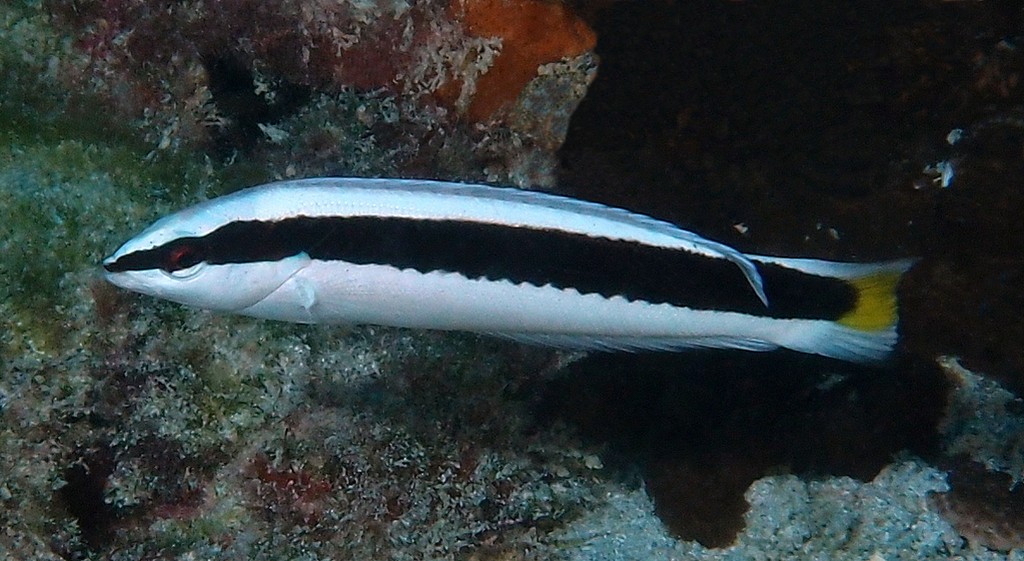CORIS PICTA - (BLOCH & SCHNEIDER, 1801)
Actinopterygii (Gigaclass) > Actinopteri (Class) > Teleostei (Subclass) > Labriformes (Order) > Labroidei (Suborder) > Labridae (Family) > Coris (Genus)
Comb wrasse, Combfish, Comb-fish, Bananafish, Australian comb wrasse,
Synonymes
Coris pictus (Bloch & Schneider, 1801)
Coris semicincta (Ramsay, 1883)
Labrus pictus (Bloch & Schneider, 1801)
------------------------
Description
Dorsal spines (total): 9; Dorsal soft rays (total): 12; Anal spines: 3; Anal soft rays: 12; Pectoral fins ays : 14; Lateral line scales: 77-92; Gill rakers: 18-21. Depth of body: 3.7-4.5 in SL (depth usually proportionally less in larger individuals); Head length: 3.0-3.6 in SL (head usually proportionally shorter in larger individuals); Diameter of orbit varying from: 4.2 in head (of 45-mm juvenile) to 6.6 (212-mm male); First two dorsal spines not elongate and flexible in adults, and the bases not closer together than remaining spines; Dorsal spines progressively longer, the first about three-fourths the length of second, the last: 3.0-3.3 in head; Caudal fin rounded: 1.3-1.6 in head (fin relatively longer in smaller individuals); Pectoral fins: 1.45-1.7 in head; Pelvic fins short: 1.5-2.2 in head (fins longest in 212-mm male, just reaching anus). Anterior canine teeth more than twice as large as second teeth in jaws. Max. length: 25.0 cm TL. Depth range: 3 - 25 m.
Color
Long white body with a prominent, wide, black stripe from its mouth across its eye along the body to the end of the tail. The lower margin of the stripe is wavy and comb-like. The portion of the stripe on the tail fin turns yellow during the breeding season. Also, a thin, red stripe runs along the top of the body from the mouth, along the base of the dorsal fin, for the fin's full length.
Comb wrasse, Combfish, Comb-fish, Bananafish, Australian comb wrasse,
Synonymes
Coris pictus (Bloch & Schneider, 1801)
Coris semicincta (Ramsay, 1883)
Labrus pictus (Bloch & Schneider, 1801)
------------------------
Description
Dorsal spines (total): 9; Dorsal soft rays (total): 12; Anal spines: 3; Anal soft rays: 12; Pectoral fins ays : 14; Lateral line scales: 77-92; Gill rakers: 18-21. Depth of body: 3.7-4.5 in SL (depth usually proportionally less in larger individuals); Head length: 3.0-3.6 in SL (head usually proportionally shorter in larger individuals); Diameter of orbit varying from: 4.2 in head (of 45-mm juvenile) to 6.6 (212-mm male); First two dorsal spines not elongate and flexible in adults, and the bases not closer together than remaining spines; Dorsal spines progressively longer, the first about three-fourths the length of second, the last: 3.0-3.3 in head; Caudal fin rounded: 1.3-1.6 in head (fin relatively longer in smaller individuals); Pectoral fins: 1.45-1.7 in head; Pelvic fins short: 1.5-2.2 in head (fins longest in 212-mm male, just reaching anus). Anterior canine teeth more than twice as large as second teeth in jaws. Max. length: 25.0 cm TL. Depth range: 3 - 25 m.
Color
Long white body with a prominent, wide, black stripe from its mouth across its eye along the body to the end of the tail. The lower margin of the stripe is wavy and comb-like. The portion of the stripe on the tail fin turns yellow during the breeding season. Also, a thin, red stripe runs along the top of the body from the mouth, along the base of the dorsal fin, for the fin's full length.
Etymology
Coris: from Greek, coris = summit, head. Name given to this genus by Philibert Commerson (1727-1773), referring to scaly plate that encompasses skull, eyes and jaws of all wrasses.
picta: from Latin, pingo = I paint, having been decorated, painted, portrayed. Described as having a cinnabar dorsal fin, a sky-blue back, and short transverse streaks on sides (the wavy or comb-like black stripe from snout through eye to caudal fin base).
Original description: Labrus pictus Bloch & Schneider, 1801 - Type locality: New South Wales, Australia.
Distribution
Southwestern Pacific: Eastern Australia, Lord Howe Island, Norfolk Island, New Caledonia, Kermadec Islands, New Zealand.
Coris: from Greek, coris = summit, head. Name given to this genus by Philibert Commerson (1727-1773), referring to scaly plate that encompasses skull, eyes and jaws of all wrasses.
picta: from Latin, pingo = I paint, having been decorated, painted, portrayed. Described as having a cinnabar dorsal fin, a sky-blue back, and short transverse streaks on sides (the wavy or comb-like black stripe from snout through eye to caudal fin base).
Original description: Labrus pictus Bloch & Schneider, 1801 - Type locality: New South Wales, Australia.
Distribution
Southwestern Pacific: Eastern Australia, Lord Howe Island, Norfolk Island, New Caledonia, Kermadec Islands, New Zealand.
Biology
Inhabits fairly deep sandy bottoms around rocky reefs. Oviparous, distinct pairing during breeding. Juveniles act like cleaner fish. This species can also be found in the aquarium trade.
Similar species
Coris musume (Jordan & Snyder, 1904) - Reported from Western Pacific: Taiwan north to Japan.
Coris pictoides (Randall & Kuiter, 1982) - Reported from New Caledonia. Juveniles are similar in color.
Inhabits fairly deep sandy bottoms around rocky reefs. Oviparous, distinct pairing during breeding. Juveniles act like cleaner fish. This species can also be found in the aquarium trade.
Similar species
Coris musume (Jordan & Snyder, 1904) - Reported from Western Pacific: Taiwan north to Japan.
Coris pictoides (Randall & Kuiter, 1982) - Reported from New Caledonia. Juveniles are similar in color.
Labroides bicolor (Fowler & Bean, 1928) - Reported from New Caledonia - Link to the species (here).
Labroides dimidiatus (Valenciennes, 1839) - Reported from New Caledonia - Link to the species (here).
Labroides pectoralis (Randall & Springer, 1975) - Reported from New Caledonia - Link to the species (here).
Last update: 13, June 2024
